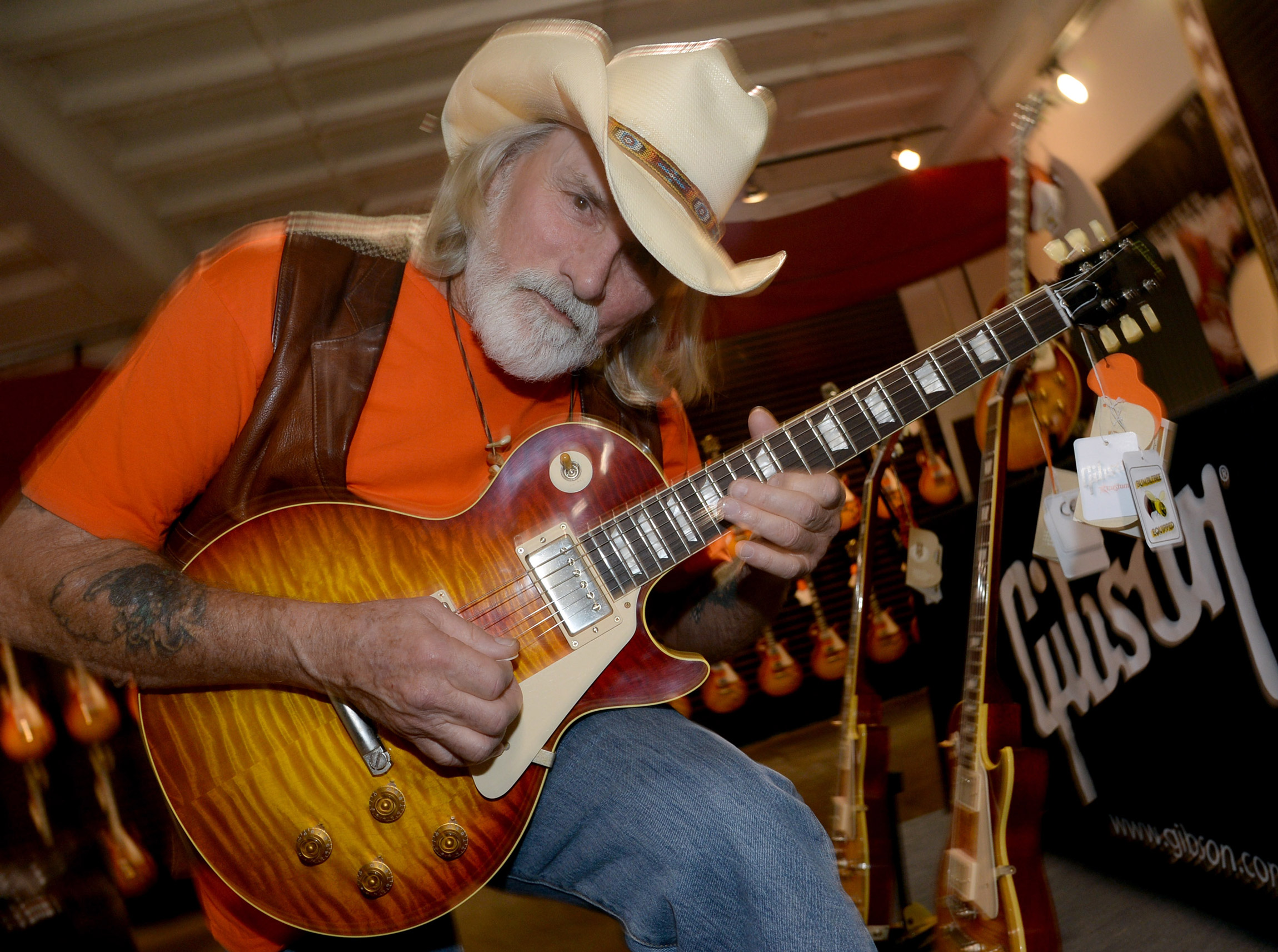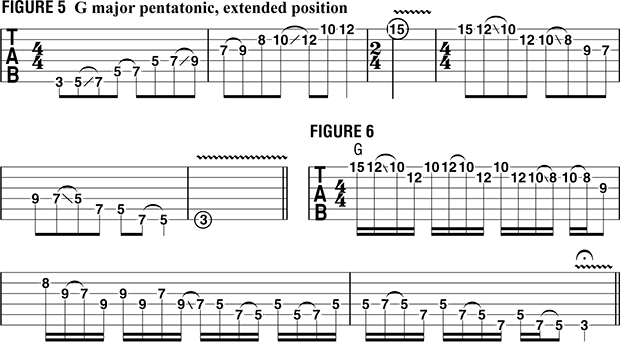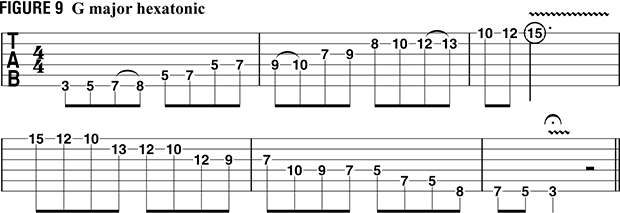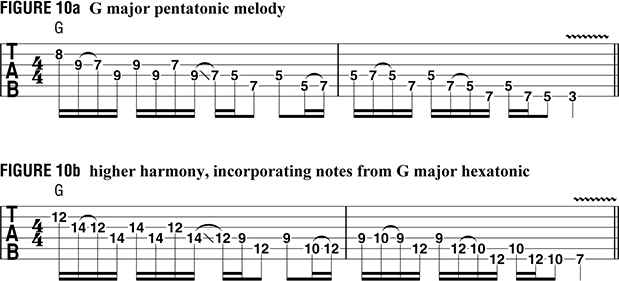How to Play Like Dickey Betts of the Allman Brothers Band and Great Southern

Forrest Richard “Dickey” Betts, founding member of the legendary Allman Brothers Band, successful solo artist and leader of his own ensemble, Great Southern, possesses one of the most distinct and influential guitar styles in the history of rock.
Combining elements of blues, rock, jazz, country, folk, bluegrass and world music, Dickey Betts forged his signature sound while laying the groundwork—along with Grateful Dead guitarist/leader Jerry Garcia—for the unique, progressive and forever mysterious genre known as “jam band” music.
In this edition of In Deep, we’ll take a look at a few of the scales Dickey relies on most when weaving his classic solos and melodic patterns.

One of the scales closely associated with the Dickey Betts sound is major pentatonic, the five-tone scale built from the first, second, third, fifth and sixth major scale degrees. FIGURE 1 illustrates G major pentatonic (G A B D E) as played in “open” position, using open strings. This pattern is used very often for soloing in bluegrass and country music, and Dickey learned about its use in this context as a young child, playing acoustic “string music” with his father and uncles.

A common technique when soloing with this scale is to use the minor, or “flatted,” third as a passing tone between the second and the major third. In the key of G, the minor third is Bb and the major third is B. FIGURE 2 presents a Betts-like bluegrass-style three-bar solo that features the use of the flatted-third passing tone as well as many hammer-ons, pull-offs and finger slides, used to yield a smooth, legato sound.

As is the case when studying any scale, it is essential to plot it out on every area of the fretboard and memorize it. FIGURE 3 illustrates G major pentatonic as played in second/third position, with a quick shift up to fifth position and then back to third position on the high E string. This pattern encompasses only fretted notes, so it is easily moved to other positions and keys up and down the fretboard.

One of the signature elements in Dickey’s soloing style is his use of small melodic “cells” that progress in either an ascending or descending manner throughout a phrase. FIGURE 4 shows a solo pattern based on the previously shown scale position of G major pentatonic and built from steadily descending 16th-note melodic cells on each beat. As you play through the figure, notice the subtle differences in the melodic shape of each four-note group as it falls on each successive beat. Classic examples of Betts utilizing this specific technique can be heard on perennial Allman Brothers favorites like “Jessica,” “Melissa” and “Ramblin’ Man.”

The major pentatonic scale lends itself well to performance over large spans of the fretboard, especially when incorporating hammer-ons and slides in order to shift quickly from one position to another. FIGURE 5 illustrates G major pentatonic in an extended pattern that starts in third position and ends in 12th. Play this pattern up and down utilizing the hammer-ons, pull-offs and legato finger slides as shown.
In FIGURE 6, I use this extended pattern to weave another three-bar solo-type phrase that moves smoothly from position to position. When forming the four-note melodic cells, one phrase can be connected to the next using a great variety of choices. At the end of bar 2 into bar 3, I decided to repeat the G root note on the downbeat of beat one in bar 3 to begin the subsequent phrase.

As alluded to in FIGURE 2, passing tones are very useful when building solo phrases from the major pentatonic scale. Along with using the minor third as a passing tone into the major third, the minor, or “flatted,” sixth works great as a connecting note between the fifth and major sixth. In FIGURE 7, I use both of these passing tones in different octaves in order to shape a more interesting melodic line. At the end of the phrase, on beat three of bar 2, I use an oblique bend—a bent note on one string coupled with an unbent note on a different string—to wrap up the phrase.

The sound of oblique bends is one closely associated with the pedal-steel guitar, and Dickey often mimics the pedal-steel sound by incorporating alternating oblique bends in his solo phrases. In FIGURE 8, an A note on the B string’s 10th fret is bent up one whole step, to B, and held while a series of alternating notes are played against it on the high E string. It will take practice to hold this bend firmly and in tune while switching between the different notes on the high E, and I suggest using the middle finger for the bend and the other three fingers for the notes fretted on the high E string.


Another scale that Betts uses to great effect is the six-note major hexatonic, which is nearly identical to the major pentatonic, the difference being that it additionally includes the perfect fourth (in the key of G, that would be C). As depicted in FIGURE 9, G major hexatonic is built from the notes G A B C D E. The major hexatonic can be used very effectively when harmonizing a major pentatonic line. FIGURE 10a illustrates a classic Betts-style major pentatonic melody, and FIGURE 10b harmonizes this melody a third higher, using notes from the G major hexatonic scale (G A B C D E).

Dickey’s best-known use of major hexatonic is most likely within his song, “Blue Sky,” and FIGURES 11a and 11b offer a G major hexatonic melody and a lower harmony line, thirds apart, the latter being based on G major pentatonic.
Get The Pick Newsletter
All the latest guitar news, interviews, lessons, reviews, deals and more, direct to your inbox!
Guitar World Associate Editor Andy Aledort is recognized worldwide for his vast contributions to guitar instruction, via his many best-selling instructional DVDs, transcription books and online lessons. Andy is a regular contributor to Guitar World and Truefire, and has toured with Dickey Betts of the Allman Brothers, as well as participating in several Jimi Hendrix Tribute Tours.
“There are so many sounds to be discovered when you get away from using a pick”: Jared James Nichols shows you how to add “snap, crackle and pop” to your playing with banjo rolls and string snaps
Don't let chord inversions bamboozle you. It's simply the case of shuffling the notes around









![Joe Bonamassa [left] wears a deep blue suit and polka-dotted shirt and plays his green refin Strat; the late Irish blues legend Rory Gallagher [right] screams and inflicts some punishment on his heavily worn number one Stratocaster.](https://cdn.mos.cms.futurecdn.net/cw28h7UBcTVfTLs7p7eiLe.jpg)


